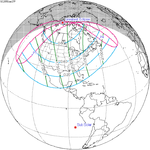Solar eclipse of January 27, 2055
| Solar eclipse of January 27, 2055 | |
|---|---|
| Type of eclipse | |
| Nature | Partial |
| Gamma | 1.155 |
| Magnitude | 0.6932 |
| Maximum eclipse | |
| Coordinates | 69°30′N 112°12′W / 69.5°N 112.2°W |
| Times (UTC) | |
| Greatest eclipse | 17:54:05 |
| References | |
| Saros | 122 (60 of 70) |
| Catalog # (SE5000) | 9630 |
A partial solar eclipse will occur at the Moon's descending node of orbit on Wednesday, January 27, 2055, with a magnitude of 0.6932. A solar eclipse occurs when the Moon passes between Earth and the Sun, thereby totally or partly obscuring the image of the Sun for a viewer on Earth. A partial solar eclipse occurs in the polar regions of the Earth when the center of the Moon's shadow misses the Earth. It will be visible across North America.
Related eclipses
Eclipses in 2055
- A partial solar eclipse on January 27, 2055.
- A total lunar eclipse on February 11, 2055.
- A total solar eclipse on July 24, 2055.
- A partial lunar eclipse on August 7, 2055.
Metonic
- Preceded by: Solar eclipse of April 11, 2051
- Followed by: Solar eclipse of November 16, 2058
Tzolkinex
- Preceded by: Solar eclipse of December 16, 2047
- Followed by: Solar eclipse of March 11, 2062
Half-Saros
- Preceded by: Lunar eclipse of January 22, 2046
- Followed by: Lunar eclipse of February 2, 2064
Tritos
- Preceded by: Solar eclipse of February 28, 2044
- Followed by: Solar eclipse of December 27, 2065
Solar Saros 122
- Preceded by: Solar eclipse of January 16, 2037
- Followed by: Solar eclipse of February 7, 2073
Inex
- Preceded by: Solar eclipse of February 17, 2026
- Followed by: Solar eclipse of January 7, 2084
Triad
- Preceded by: Solar eclipse of March 28, 1968
- Followed by: Solar eclipse of November 28, 2141
Solar eclipses of 2054–2058
This eclipse is a member of a semester series. An eclipse in a semester series of solar eclipses repeats approximately every 177 days and 4 hours (a semester) at alternating nodes of the Moon's orbit.[1]
| Solar eclipse series sets from 2054 to 2058 | ||||
|---|---|---|---|---|
| Ascending node | Descending node | |||
| Saros | Map | Saros | Map | |
| 117 | August 3, 2054 Partial |
122 | January 27, 2055 Partial | |
| 127 | July 24, 2055 Total |
132 | January 16, 2056 Annular | |
| 137 | July 12, 2056 Annular |
142 | January 5, 2057 Total | |
| 147 | July 1, 2057 Annular |
152 | December 26, 2057 Total | |
| 157 | June 21, 2058 Partial | |||
Saros 122
It is a part of Saros cycle 122, repeating every 18 years, 11 days, containing 70 events. The series started with a partial solar eclipse on April 17, 991 AD. It contains total eclipses from July 12, 1135 through August 3, 1171, hybrid eclipses on August 13, 1189 and August 25, 1207, and annular eclipses from September 4, 1225 through October 10, 1874. The series ends at member 70 as a partial eclipse on May 17, 2235. The longest duration of totality was 1 minute, 25 seconds on July 12, 1135, and the longest duration of annularity was 6 minutes, 28 seconds on October 10, 1874.
| Series members 52-68 occur between 1900 and 2200: | ||
|---|---|---|
| 52 | 53 | 54 |
 November 2, 1910 |
 November 12, 1928 |
 November 23, 1946 |
| 55 | 56 | 57 |
 December 4, 1964 |
 December 15, 1982 |
 December 25, 2000 |
| 58 | 59 | 60 |
 January 6, 2019 |
 January 16, 2037 |
 January 27, 2055 |
| 61 | 62 | 63 |
 February 7, 2073 |
 February 18, 2091 |
 March 1, 2109 |
| 64 | 65 | 66 |
 March 13, 2127 |
 March 23, 2145 |
 April 3, 2163 |
| 67 | 68 | |
 April 14, 2181 |
 April 25, 2199 | |
References
- ^ van Gent, R.H. "Solar- and Lunar-Eclipse Predictions from Antiquity to the Present". A Catalogue of Eclipse Cycles. Utrecht University. Retrieved 6 October 2018.

